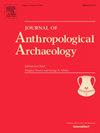揭示南巴塔哥尼亚狩猎采集者岩石绘画设计的空间结构和信息流动
IF 2.2
1区 社会学
Q1 ANTHROPOLOGY
引用次数: 0
摘要
最近在Pali Aike火山区(PAVF,阿根廷南部和智利)进行的岩石艺术研究扩大了年代(约3100b.p.)以及“Río Chico风格”抽象几何和具象绘画的形态和技术库。本文讨论了绘画图案的空间分布,以了解在全新世晚期占据PAVF的狩猎采集者之间指导表征策略和信息流动的标准。通过使用社会网络分析和统计测试,检测到地理位置不同的两组岩石艺术地点,以及图案的丰富性和丰富性。此外,地理距离在区域水平上对基序类分布的空间结构起着关键作用,近的位置(约20 km)之间存在显著的相似性,而远的位置(约60 km)之间存在显著差异。因此,岩石艺术绘画作为与古代信息流动和人类在大空间尺度上的流动模式相关的文化特征,遵循了其他考古证据所描述的空间趋势,这些证据表明了PAVF各部分之间,特别是加莱戈斯河(北部部分)和奇科河(南部部分)之间人类土地利用和职业强度的不同形式。本文章由计算机程序翻译,如有差异,请以英文原文为准。
Unveiling the spatial structure of rock painting designs and information flow among hunter-gatherers in southern Patagonia
Recent rock art research in the Pali Aike volcanic field (PAVF, southern Argentina and Chile) expanded the chronology (ca. 3100B.P.) and morphological and technical repertoire of abstract-geometric and figurative paintings of the “Río Chico style”. This paper discusses the spatial distribution of painted motifs to understand the criteria that guided the representation strategies and the flow of information among the hunter-gatherers that occupied the PAVF during the late Holocene. By employing social network analysis and statistical tests, two main groups of rock art locations that differ in geographic position, plus the richness and abundance of motifs, were detected. Furthermore, geographical distance was observed to have played a key role in determining the spatial structuring of motif class distribution at the regional level, with significant similarities existing between nearby locations (ca. 20 km) and important differences between more distant ones (ca. 60 km). Thus, rock art paintings as cultural features related to an ancient flow of information and human mobility patterns at a large spatial scale, follow the spatial trend described by other lines of archaeological evidence, which indicates different forms of human land use and occupational intensity between sectors of the PAVF, particularly between the Gallegos (northern sector) and Chico (southern sector) Rivers.
求助全文
通过发布文献求助,成功后即可免费获取论文全文。
去求助
来源期刊

Journal of Anthropological Archaeology
Multiple-
CiteScore
4.00
自引率
11.10%
发文量
64
期刊介绍:
An innovative, international publication, the Journal of Anthropological Archaeology is devoted to the development of theory and, in a broad sense, methodology for the systematic and rigorous understanding of the organization, operation, and evolution of human societies. The discipline served by the journal is characterized by its goals and approach, not by geographical or temporal bounds. The data utilized or treated range from the earliest archaeological evidence for the emergence of human culture to historically documented societies and the contemporary observations of the ethnographer, ethnoarchaeologist, sociologist, or geographer. These subjects appear in the journal as examples of cultural organization, operation, and evolution, not as specific historical phenomena.
 求助内容:
求助内容: 应助结果提醒方式:
应助结果提醒方式:


